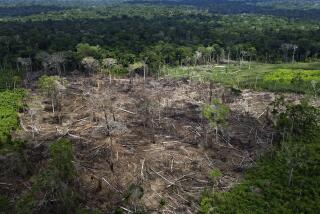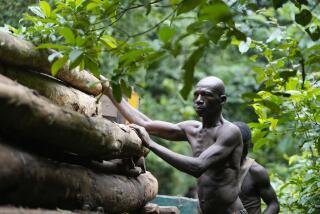Laos’ Natural Resources on the Run From Deforestation, Poachers
VIENTIANE, Laos — The mighty animals that made Laos the Kingdom of a Million Elephants are mostly gone. And every year the forests that once blanketed the country from end to end are replaced by more bald hillsides and scrubland where hardly a birdsong is heard.
Long spared the depredations that scarred neighboring Vietnam, Thailand and China, Laos’ 5.6 million people still enjoy a high ratio of water and forest resources, including 800 bird and 100 mammal species ranging from tigers to the recently discovered giant muntjack and saola.
But conservationists are alarmed at what has been eradicated in less than a generation. They fear that minimal environmental programs run by creaky Communist Party machinery, riddled with corruption and supported by limited foreign aid, has no chance to slow the destruction.
They argue that short-term profits from profligate logging and other ventures will be a disaster in the long run.
“The only thing Laos can offer economically is its natural resources and biodiversity. That is its comparative advantage. If it loses that, it’s done for,” said Roland Eve, country director of the World Wide Fund for Nature.
Laos is one of the world’s poorest and least developed nations, and the pressure is intense to build hydroelectric dams and sell off tropical forests, legally or otherwise.
Along the 280-mile length of National Highway 13, which runs north-south through the heart of Laos, the only patches of viable forest are inside ravines or on mountain slopes too steep to log. During the dry season, smoke from woodlands cleared for farming casts a hazy shroud.
Forest cover has shrunk from 70% of Laos’ total area in the middle of the 20th century to less than 40% today -- and possibly far lower, environmentalists say.
Many woodlands are described as “dead” due to over-hunting.
Near the northern town of Udomxai, a Kamu tribal girl holds up two dead civet cats by their tails alongside several braces of tiny birds, trying to tempt passing bus passengers. In the town’s market, civet meat, selling for 90 cents a pound, lies next to the carcasses of multicolored parrots and other forest creatures.
“Everything in Laos is considered food, except maybe cockroaches,” said Troy Hansel of the New York-based Wildlife Conservation Society.
Wildlife is also used in traditional medicines and tonics, such as a concoction of leaf monkey, porcupine stomach and bamboo rat mixed in alcohol that is said to infuse its drinkers with the power of trees (since all three animals feed on them).
But experts say traditional local consumption isn’t the real threat to wildlife and woods, at least over the next two decades.
“The illegal trade to China is the major danger, as it is to all the adjacent countries,” author Gordon Claridge said of the Chinese appetite for everything from turtles to tigers. “Whenever there are in-depth studies of trade in a particular wildlife group, it seems that China comes up as the major destination.”
Claridge and his wife, Hanneke Nooren, are authors of “Wildlife Trade in Laos: the End of the Game,” which details the trade and involvement in it by Lao government and military officials.
Since the book appeared in 2001, the sale of wildlife in Laos’ markets and restaurants has been less blatant, conservation workers say, but they suspect that much dealing has gone underground.
“The government says no logging, no shooting wildlife and no smoking opium, and along the roads, people are afraid. But deeper inside, they do it all after dark,” trekking guide Somphone Rattanachindavong said, just as another gunshot is heard in the distance from inside the Luang Namtha Nam Ha National Biodiversity Conservation Area.
In the northern highlands, the 860-square-mile reserve is one of Laos’ biggest wilderness tracts. Among its denizens are a few wild elephants, once plentiful symbols of royal power that are now scattered in shrinking, furtive herds.
The 20 protected areas, first decreed in 1993, cover 14% of the country, but they are derided by critics as “paper parks.” The government allocates just $500 a year for each reserve, leaving them unguarded against slash-and-burn farming, livestock grazing, illegal logging and game poaching.
In addition, U.N. reports say the building of hydroelectric dams will harm 12 of the 20 reserves. A dozen parks lie along international frontiers, making it even easier for smugglers to work.
The biggest illegal trade involves wildlife and flora being smuggled into Vietnam and then funneled to China, where their use in traditional medicines and food has increased greatly since the late 1980s, when the Chinese economy began to prosper.
“The government is more aware of environmental problems, but doesn’t have the human resources to tackle them,” said Latsamay Sylavong, who works for the Switzerland-based World Conservation Union.
Laos has only a handful of trained officials, no experts in birds or elephants, and no local activist groups concerned with the environment. None of the country’s old-style Communist leaders, who are the real decision-makers, have shown an interest in environmental issues.
Latsamay says the government is focused on economic development, including the building of roads to remote communities.
“Suddenly, income-earning opportunities like wildlife sale and logging come to people’s doorsteps and most can’t resist them. They don’t think about the future,” she said. “And the government thinks only about building a road, but this opening up comes without education.”
More to Read
Sign up for Essential California
The most important California stories and recommendations in your inbox every morning.
You may occasionally receive promotional content from the Los Angeles Times.










